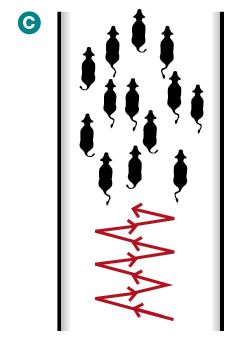Effective Corral Work: Part 2

Conventionally, alleyways are used not only for livestock movement, but for storage. From the low-stress perspective, however, this is hard on animals and will unnecessarily hurt performance. Cattle don’t like to be crowded to the point that they bump into each other. When they are, their anxiety and stress levels go way up, and they’ll likely be less cooperative because their minds will be going back to where they were last comfortable. What we’re doing is making the whole corral experience bad, which makes those cattle harder to work the next time.
For one thing, whenever we store animals in an alleyway and we go in from the front to peel off a draft to take to the crowd tub, scale, loading dock, etc., we are too tough on the ones in the back (i.e., all the animals crowd to the rear of the alley, which puts immense pressure on those in the back).
What we should do is store our animals in corral pens and bring out drafts (as described in Effective Corral Work: Part 1) and only use the alleyway for transport.
However, if we do use our alleyways for storage there are several things we can do to make it less stressful on the animals. First, we can give them plenty of room by storing fewer cattle at a time (see image above).
Another thing we can do is put a person at the end of the alleyway to keep the animals from pressing up against the back. Also, as the handler comes to peel off another draft, the cattle will be facing forward so he or she can walk against the animals (i.e., reverse-parallel) along the fence to get them to come out past him or her.

One person driving cattle up an alleyway
Conventionally, how do people drive cattle up an alleyway? They generally fall in directly behind them and push (often with the aid of noise, stock whips, flags or paddles). But pushing on cattle from directly behind has several negative consequences: (1) they don’t like it because we’re in their blind spot; (2) so they try to pick up where we are; (3) so they’re not moving ahead like they should; (4) and not driving the ones in front of them like they should; and (5) if we continually apply pressure from directly behind, some animals might break back to relieve the pressure.
As we’ve discussed in previous articles, there is a more effective way to drive cattle ahead from behind: the straight-lined, forward-angled zigzag.
Two people driving cattle up an alleyway
If there are two people driving animals up an alleyway they should each stay close to the fence and zigzag behind the cattle in front of them. That keeps the animals going straight down the alleyway and not wanting to turn back.

Working alleyways from the outside
Another way to effectively move cattle up an alleyway is to walk or ride reverse-parallel on the outside of the alleyway. Attempting this inside an alleyway is too much pressure for most animals. As you pass each animal’s balance point it should speed up in the direction it’s going.
If animals stall out
An effective way to resume movement in animals that are stalled out in an alleyway is the “rocking” technique, in which you literally rock back and forth. This applies a surprising amount of pressure on animals and drives them ahead.
Stopping animals that break back
We first need to take responsibility for any animal breaking back with the realization that we caused it (i.e., by over-pressuring or being out of position). Animals only break back when we shove them from behind and they have nowhere else to go.
When an animal does break back, the conventional response is to jump in front of it to try to stop it. But what does that do? It actually puts more pressure on the animal so it wants to go back even more. (Remember Principle #12: Under excess pressure, animals want to go back where they came from.)
The better response is to back up a step or two. That instantly releases pressure on the animal, and it will almost always stop, reconsider and turn back to its mates.
Stopping animals that are coming at you
To stop animals in an alleyway that are coming toward you, rock back and forth, and back up if necessary. Our tendency is to go directly at them, but that actually tells them to go by you because it is a reverse-parallel movement.
Conclusion
Corral work can be a highly stressful time for our cattle, but it needn’t be so if we apply low-stress principles and techniques, then they understand what we want and will willingly comply.








